There is a formula that always works: tracking Amazon sales leads to more Amazon sales.
That’s because your sales data pictures your audience’s buying behaviors. You discover what they like or don’t like to buy and which items are selling better than others. With this knowledge, you can adjust your Amazon business strategy to boost sales.
BUT! Amazon Seller Central pours so much data your way that it can be difficult to know what’s important and what’s not (tracking everything is nearly impossible).That’s why we’ve compiled a list of the 14 most important Amazon seller metrics you must track to understand your performance on the platform truly.

Why Is It Crucial to Track Your Amazon Metrics?
Amazon is a never-ending sea of products and services that are constantly changing. There is fierce competition amongst sellers to attract customers and stay ahead of the curve.
There is no more “Amazon is a free market” where the game was based on selling the best product at a reasonable price. Now, Amazon has its own rules and algorithms that determine which products will be featured and which ones will be hidden in the search results.
Currently, around 46% of Amazon sellers are considered successful, while during the old days of Amazon, registering a product and selling it at a competitive price was all you needed to be successful.
With the rise in competition, tracking metrics used by Amazon has become crucial for sellers looking to succeed on the platform.
Thus, these metrics give valuable insights into how your products are performing and help you make informed decisions about improvements you can make to increase sales.
Which Amazon Metrics Should You Track? The 5 Key KPI Categories
The KPIs you track largely depend on your business and what you want to achieve. However, some key metrics by Amazon hold true for most sellers and should be tracked regularly. We can categorize these into several categories.
- Product Visibility metrics: how easily your products can be found by customers, including search ranking and click-through rates.
- Amazon Sales metrics: how well your products are selling, including total sales, conversion rates, and unit session percentages.
- Inventory metrics: how well you are managing your inventory levels to meet demand and avoid stockouts. These include metrics used by Amazon like sell-through rate and days of inventory cover.
- Customer relationship metrics: how satisfied your customers are with their purchases, including reviews, feedback ratings, and return rates.
- Advertising metrics: how well your advertising campaigns are performing and how much return you’re getting on your investment.
Let’s see what each category holds and where you can find these metrics.
Product Visibility Metrics
In the overcrowded marketplace of Amazon, your first fight is to get your product noticed.
The trick here is you (and most other sellers) probably try to enter the most profitable niches on Amazon. And what are Amazon’s most profitable niches? Right! The niches with the highest search volumes. This means that these niches are already highly competitive.
What holds you back from selling in less competitive niches? Less competitive niches (not always) mean lower demand and less profit.
So, if your product is unique in its niche and that’s your strategic choice, then the competition isn’t as crucial. However, more often than not, many sellers are selling the same (or very similar) product, so you need to be one step ahead of them regarding visibility.
That’s where Amazon’s Product Visibility Metrics come in handy.
1. The Amazon Featured Offer (formerly, Buy Box Percentage)
The old and kind Buy Box has now become the Amazon Featured Offer.
Technically speaking, it’s a window on the right side of the product detail page where customers can add items to their shopping carts. It appears above the “Buy Now” button and shows products that are alternatives to the main product.
Showing featured items right above the “Buy Now” button means Amazon gives you a great chance to catch customers’ attention and convert them into buyers. In other words, it increases your chances of winning the sale over other sellers.
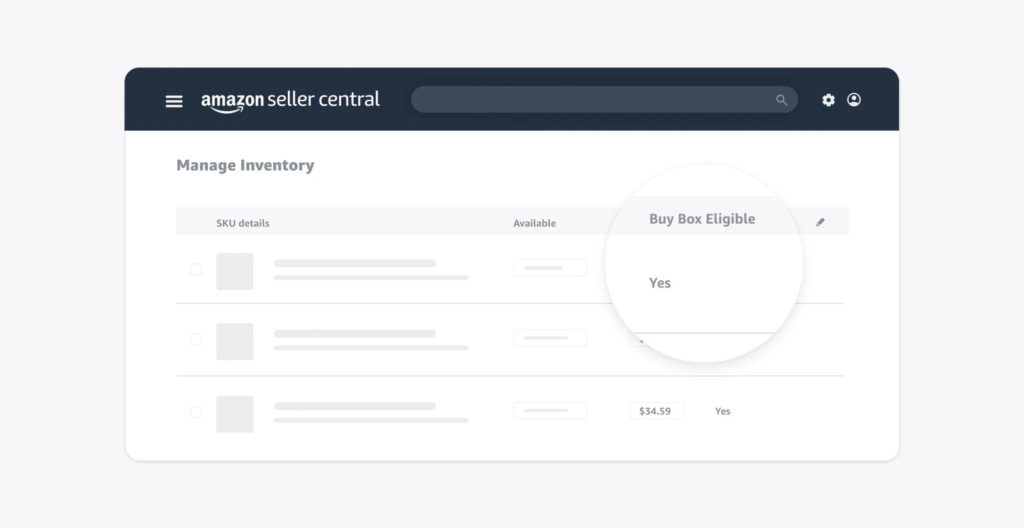
As you can guess, Amazon itself grants such a golden spot to sellers. You can’t make your products appear on the Amazon Featured Offer on your own. All you can do is improve your chances of getting it by optimizing your Amazon account, ensuring your prices are competitive, your delivery speed is fast, and most importantly, your Amazon customer satisfaction metrics are high.
So, if you do everything right, Amazon’s algorithm will (hopefully) consider your product to be the best match for customers and display it on the Featured Offer.
Note! Certain products are not eligible for the Amazon Featured Offer program, no matter how perfectly optimized your account is. Check the categories of products that are eligible for the offer.
How Do You Improve Your Chances of Being Eligible for Amazon Featured?
As said before, Amazon displays the Featured Offer depending on many factors that have the same general goal: ensuring customer satisfaction.
Here are the key things you can do to boost your chances of getting the Featured Offer.
- Upgrade your pricing plan: You need an active Professional selling plan and a well-optimized account.
- Offer reasonable prices: Featured Offer prices are usually competitive. You should make sure your prices are not absurdly high, yet you’re making profits.
- Have enough inventory in stock: No comments here. If you’re low on stock, customers won’t be able to buy from you, so what’s the point of featuring products?
- Ensure fast delivery: If not lightning speed, at least fast and reliable delivery is a must. You need to ensure that you ship products within the timeframes you’ve set.
- Keep your items in good condition: Used, damaged, or unsealed items will never get the Featured Offer. Make sure you only offer brand-new (like-new) products that are in excellent condition.
- Provide great customer service: Amazon’s algorithm considers customer satisfaction metrics to determine the eligibility of your account and products for the Featured Offer program. If you have a high number of positive reviews, low return rates, and fast response times to customer inquiries, your chances of being featured will increase.
2. Product Ranking
People can’t buy your product if they don’t see it. And since around 50% of searches start on Amazon, where your product appears in that search results matters a lot!
Product ranking is an Amazon seller metric that shows where your product appears when buyers search for it. If you don’t generate enough sales, the issue’s root might be just here.
On the contrary, if your product rankings are high, but you’re not making enough sales, then you most probably need to review your pricing strategy or overall attractiveness of your products.
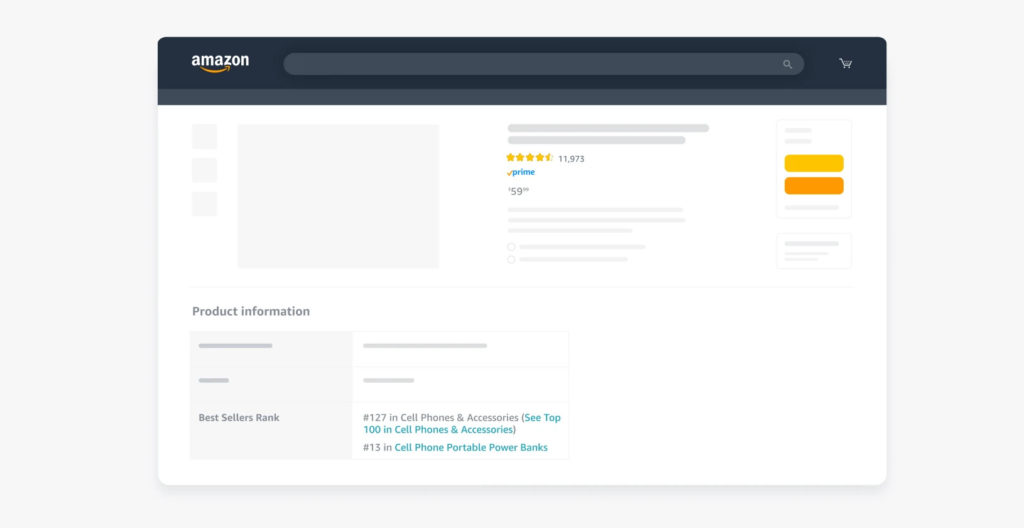
You can use the Amazon Best Sellers Rank feature to see your ranking on Amazon. Scrolling down in the product’s details section, you’ll find the Best Sellers Rank, which displays the product’s rank in its category and subcategories. It also shows how many products are in that specific category and what percentage of total sales come from your product’s rank.
Amazon product ranking is updated hourly and can be a major contributor to the success or failure of your Amazon business. This No. 1 visibility metric is the first point in your journey to get more sales.
How to Improve Product Ranking?
High product rankings result from Amazon keyword optimization, positive customer reviews, constant sales, and other tactics proving Amazon you’re a reliable seller. So, if you want your products to rank high, focus on Amazon SEO and customer satisfaction.
Here are some tips to improve your Amazon product ranking.
- Optimize your product titles and descriptions with relevant keywords. Have specific content that’s easy to read, with bullet points and images to stand out.
- Use high-quality product images that showcase your product’s features and details. Attractive visuals help buyers betater understand your product and make a purchase.
- Bring traffic to your Amazon product page from other sources: Use social media marketing, influencer collaborations, and paid ads.
- Encourage customers to leave positive reviews by providing excellent products and customer service. The more positive reviews, the higher your product’s ranking.
Amazon Sales Metrics to Track
Sales is your ultimate goal on Amazon, and seeing how well your products are converting views to purchases is essential.
It’s crucial to note we are not talking about rough sales numbers, such as how many units you have sold over a specific period. More importantly, we recommend you closely monitor user behavior before the curtains of the sales numbers come up.
For example, you may have recorded sales of 100 units for a specific product, but how many visitors out of all the visits (sessions) did you succeed in converting into customers? You have 100 units sold, and that may be good in isolation. But what if 1000 people landed on the product page, only 100 of them made a purchase and you have high potential to increase the conversion rate?
The below Amazon sales metrics will help you make decisions based on data and numbers, which is crucial for your success on Amazon.
3. Unit Session Percentage Rate or Conversion Rate
The unit session percentage (USP) rate shows the percentage of people who have visited your product page and eventually made a purchase. This metric is one of the most important Amazon seller metrics, as it shows how engaging your products are.
If your listings are not proper to convert potential buyers, high product rankings won’t help your sales.
Usually, 10-15% is considered to be a good USP rate. Anything below 10% is too low and might indicate something wrong with your listings, product pricing or delivery terms, resulting in potential buyers not being converted into customers.
Around 7% can be considered an acceptable rate if you’re a private-label seller with a high customer retention rate.
As you might guess, a unit session percentage is the key conversion seller metric on Amazon. It’s one of the best indicators of your products’ attractiveness and convertibility.
To check it, go to your Seller Central account’s Business Reports, choose the “By ASIN” section, and press “Detail Page Sales and Traffic”.
How to Improve Unit Session Percentage?
Invest in how attractive your Amazon listings are. You can also refer to bulk edit Amazon listings.
- Make eye-catchy visuals of your product.
- Write a killing copy for product description parts.
- Check if any competitor’s products offer better features or better pricing to ensure you’re offering customers the best value.

4. Pre-Fulfillment Cancellation Rate
The pre-fulfillment cancellation rate is the percentage of people who had canceled their order before it was shipped to them. For example, if 100 people purchased your product and 40 canceled the order, you have a 40% pre-fulfillment cancellation rate.
This Amazon seller metric is very important as it often indicates potential issues with your products or listings, such as misleading advertising, pricing inconsistency, delivery terms or product description inaccuracies. It can also indicate customer service issues or that a seller marks certain products available for sale when they’re not in stock.
The accepted threshold for this Amazon seller metric is 2.5%. So, if your pre-fulfillment cancellation rate exceeds this level, it’s time to take a closer look at your product listings and customer service management.
To check your pre-fulfillment cancelation rate on Amazon, head to the Account Health page in your Seller Central account. Further, navigate to the Shipping Performance section, where you will find the Pre-fulfillment Cancel Rate.
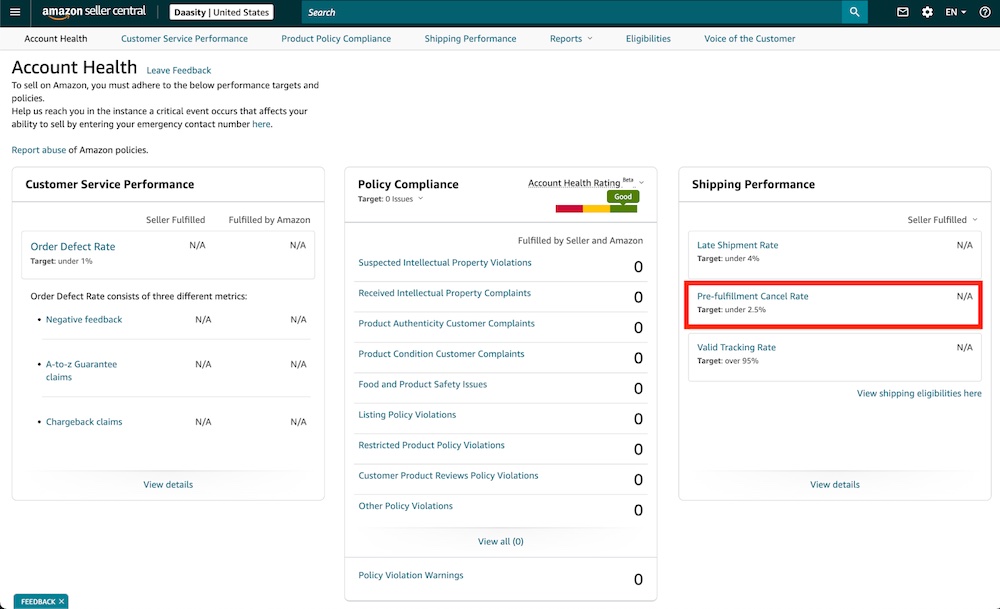
How to Improve Pre-Fulfillment Cancellation Rate?
As simple as it may sound, the key improvement tactic is always ensuring you have enough stock of the items you display in your Amazon listings.
Also, ensure that the product descriptions are accurate and that your ads communicate all essential information about each product, including pricing, delivery terms, sizes and colors available, etc.
In short, be honest and consistent in all communications with your customers.
5. Fulfillment Performance
Fulfillment performance can be described as one of the accumulative Amazon seller metrics that considers order defect rate, pre-fulfillment cancellation rate and the rate of late shipments.
While keeping the above-mentioned thresholds for the first two metrics, sellers should also ensure they do not have more than a 4% of late shipment rate. Otherwise, the overall Amazon seller performance of their business will downgrade.
Fulfillment performance is a general indicator of how well your business is managed and monitored. It shows whether you are able to keep up with the demands of customers, handle inventory properly and ensure timely product delivery.
So, if you don’t want to go into many details and track every seller metric separately, you can regularly check your account’s fulfillment performance section and make sure it stays in the acceptable range.
How to Improve Fulfillment Performance?
Nothing new here. An accurately organized inventory and well-timed product delivery are the only two guarantees for a good fulfillment performance.
Ensure you have enough stock of your items; consider using Amazon inventory management software to keep track of the stock levels and set realistic expectations for delivery times.
Inventory Metrics to Track on Amazon
Your inventory on Amazon refers to the stock of products you have available for sale. Always having enough supply and ensuring stock items are in a proper condition is only a small part of managing your inventory.
It’s crucial you avoid overstocking products, which ties up your cash flow, or understocking products, leading to lost sales opportunities. It’s also important to monitor how fast certain items of your inventory are selling out and which products are not performing well.
By learning all the insights into your inventory, you can make strategic decisions to optimize your forecasting inventory management strategies, save costs and increase profits. For example, slow-moving products can be discounted, and fast-moving products can have their stock levels increased.
Luckily, Amazon provides various tools and metrics to help you track your inventory performance. Here are some of them.
6. Inventory Performance Index
An inventory performance index is a weekly refresh metric that measures the health of your inventory. It’s calculated based on your sales levels during the previous three months, inventory levels and costs that allow Amazon to determine how well you manage your inventory supply.
IPI is a 0-1,000 scale index and you should aim for the highest possible score.
- An IPI of 450 and more is considered acceptable.
- More than 550 IPI is an excellent Amazon sales metric that is desirable to have.
- If the IPI score drops below 350, Amazon might take action and suspend your seller account, considering it risky.
An inventory performance index is a comprehensive metric that might flag any selling issues or inefficiencies reducing your sales. Aside from the risk of Amazon punishments, a low IPI score will directly result in decreased sales and profits.
How to Improve the Inventory Performance Index?
The most tried and tested strategies for improving IPI score include:
- Reducing excess inventory: An inventory that is too large ties up your cash and costs you storage fees. It’s best only to stock what you know will sell quickly.
- Ensuring you always have enough stock of your good-selling products: Such items make your inventory move quickly with the organic demand. This also reduces shipping time and drives positive customer reviews.
- Continuously improving your sell-through rate: This is the speed at which your products sell within a given time frame or the rate at which you can turn your inventory into cash. You can achieve this by keeping track of demand trends and adjusting stock levels accordingly.
In simpler words, you should try to minimize unproductive and have lean levels of stock to maximize the velocity at which you can sell through your inventory.

7. Recommend Removal
The good news with Amazon is that it lets you store your products in its warehouses. The bad news is that it charges you for storage. This means that the longer your products remain at a fulfillment center, the more expensive they become.
To help sellers manage their inventory costs effectively and improve IPI scores, Amazon provides a “Recommend removal” feature. This report literally suggests sellers remove those items from Amazon’s FCs that have been there for more than 270 days without selling.
This feature helps sellers to identify which products are not contributing positively towards their inventory performance and should be removed from the fulfillment center. By removing these low-performing products, sellers can free up space in Amazon’s warehouses and reduce their storage costs while focusing on selling high-demand items that improve the overall IPI score.
“Recommend Removal” report in your Amazon Seller Central’s seller dashboard under “FBA reports”.
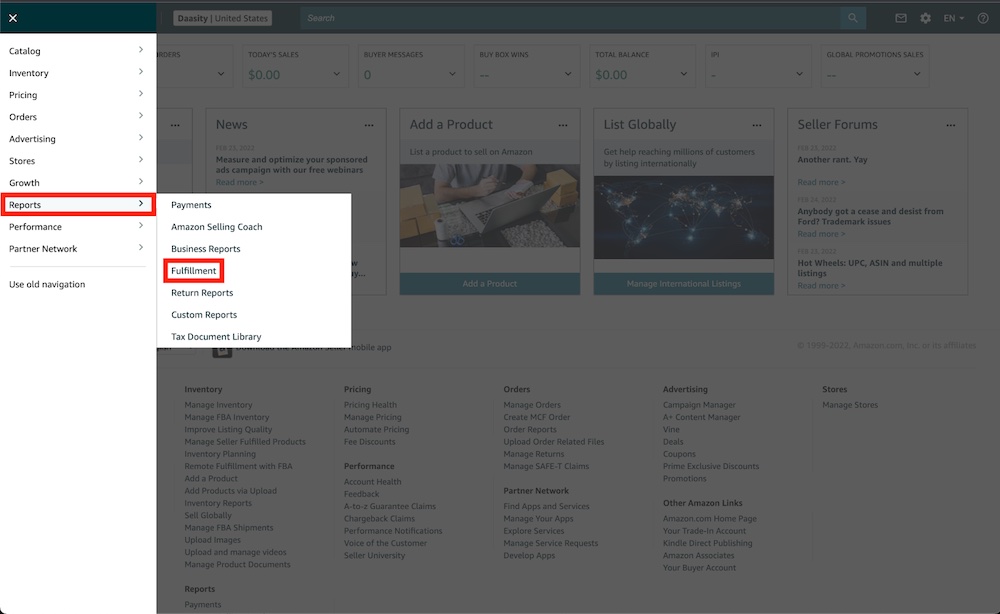
How to Have Fewer Items in the Recommend Removal Report?
Firstly, it’s not necessarily bad if you have items in the “Recommend Removal” report. It just means that those products may not be performing as well as others in your inventory and that’s your hint to stop investing in them.
You may also realize some promotional efforts or bundling offers are needed to get them moving for a more acceptable conversion rate.
To have fewer items in the “Recommend Removal” report, you can:
- Analyze Your Inventory Performance Index (IPI) Score: Keep a close eye on your IPI score. If it’s low, work on improving it by selling through old or slow-moving inventory and keeping lean levels of stock.
- Monitor Your Sales Velocity: Make sure to keep track of your sales velocity. Compare your sales data with industry benchmarks, and adjust your inventory levels accordingly. If a product isn’t selling as quickly as others, consider reducing its order frequency or volume.
- Review Your Pricing Strategy: If you notice a product consistently appearing in the “Recommend Removal” report, review its pricing strategy. It may be time to adjust the price to make it more competitive or profitable.
Customer Relationship Metrics to Track on Amazon
You should know that Amazon puts customers first. Being one of the most customer-centric e-commerce platforms, Amazon has established itself as a giant by emphasizing not only sales but also providing superior service to its customers. As an Amazon seller, you will be expected to uphold this standard and maintain strong relationships with your clients.
Most Amazon KPIs presented above consider the level of customer service you are providing to your buyers. This includes but is not limited to, how you respond to buyer inquiries, the quality and timeliness of your product shipments, and how often you receive negative customer feedback.
This section will cover some key customer relationship metrics that you should track as an Amazon seller.
8. Order Defect Rate (ODR)
Amazon Return Policies guarantee buyers they can return their purchases if unsatisfied – an essential trust factor for online shoppers.
However, Amazon does not like to see many products returned and emphasizes the order defect rate (ODR). This Amazon seller metric shows how many orders from your offer have been returned or marked as defective.
The product is considered defective if…
- A buyer makes an A-Z guarantee claim.
- There is a chargeback request from the buyer.
- Your product gets a 1-2 stars review after the purchase.
Whenever your ODR surpasses 1%, you risk being punished by Amazon. It can suspend you or even close your seller account. So, be careful!
How to Lower ODR?
You should identify the reason behind the return request at any cost, as that’s the only way to lower your ODR.
Usually, Amazon includes the customer’s provided return reason in the notification email. Read it carefully and take appropriate actions to prevent similar cases from happening in the future.
You can also check Reports -> Fulfillment -> Customer Concessions -> Returns to get a comprehensive list of all returned orders and their reasons.
It’s always better to take a break and inspect your inventory and product quality rather than risk suspension or account closure.
9. Late Shipment Rate
There is an expected shipment date for each order you receive as an Amazon seller. You are expected to ship the product within the specified time frame, and if any delay ensues, it is your responsibility to notify the customer immediately. Your late shipment rate (LSR) metric measures how often you fail to meet this expectation.
Late shipments are any shipments that are done after 3-4 days from the expected shipment date, and they are a red flag for Amazon. LSR should be kept below 4% if you are to remain in good standing as a seller. Moreover, failure to meet this threshold may lead to account suspension or closure by Amazon.
Your late shipment rate is stored on Seller Central’s Account Health page. Choose the “Shipping Performance” section, then click on the “Late Shipping Rate” to see where you currently stand with this metric.
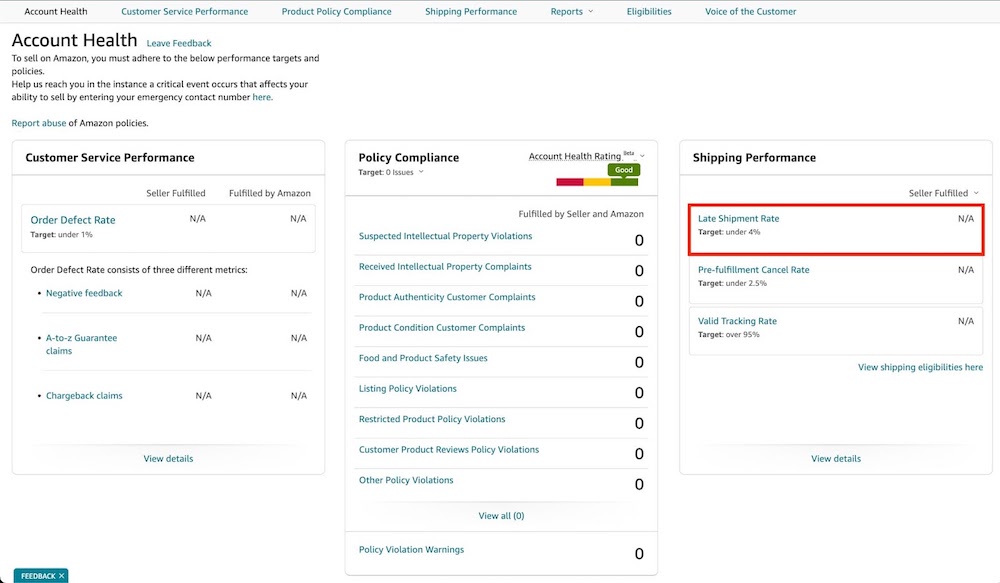
How to Lower Late Shipment Rate?
Well, not a big magic! Make sure you monitor your inventory levels regularly and fulfill orders in a timely manner. If any delay is expected, let the customer know as soon as possible.
If you feel there are issues with your logistics or shipping process, take immediate steps to address the problem. The issue may be due to internal factors, such as inadequate staffing or inefficient processes, or external factors, such as delays from your suppliers.
Whatever it is, that’s a too costly mistake to ignore. So, it is important that you actively monitor and improve your late shipment rate to maintain a good relationship with both Amazon and your customers.
If you feel delivery speeds can’t be improved, you can try using alternative shipping options like Amazon’s FBA (Fulfillment by Amazon) or third-party fulfillment services. These services may help you meet your delivery expectations and improve your late shipment rate.
10. Buyer-Seller Contact Response Time (CRT)
Amazon is one of the most customer-centric brands… have we already told you that? They focus on providing the best customer experience possible. That’s why responding to buyer inquiries in a timely manner is crucial for your success as an Amazon seller.
Your Buyer-Seller Contact Response Time (CRT) is measured from the moment a buyer sends you a message through the “Contact Seller” button on your product listing until you respond. This response time includes weekends and holidays, so it is important to monitor your messages constantly.
You are expected to answer within 24 hours. Meanwhile, autoresponders don’t count here.
Why is CRT important? Well, for starters, Amazon considers it an indicator of seller performance. A low response time can lead to higher customer satisfaction and increased sales. On the other hand, a high response time may result in negative feedback or even suspension of your account.
How to Improve CRT?
So, how do you improve your CRT? The key is to monitor your messages actively and respond quickly. You can also use Amazon email automation tools or hire virtual assistants to help manage your customer inquiries. By providing timely and helpful responses, you can not only improve your seller performance metrics but also build trust with your customers.
Additionally, you should mark some messages as “No Response Required” if they do not require a response, such as thank you notes or messages requesting more information. This will help improve your CRT and reduce the number of messages in your inbox.
11. Product Reviews
Stats show that positive reviews increase sales by 20% on average, increasing customers’ trust in your product and brand. Meanwhile, an item with reviews has around 65% more chances to be sold than an item without reviews.
So, continuously tracking your desired 5-star rating and collecting customer reviews is one of the most important Amazon seller metrics to measure your products’ performance and identify customers’ needs and preferences.
Product reviews can be checked individually for each ASIN, but the accumulated data is also collected in Amazon’s brand catalog manager to have the big picture of your brand’s performance.
How to Improve Product Reviews?
Perhaps, boosting positive product reviews is one of the most complex tasks for Amazon sellers, as getting humans’ reactions is highly unpredictable. Here are some tips that might help you to increase the number of positive reviews:
- Automate Thank You Amazon feedback emails.
- Have advanced Amazon feedback management.
- Make sure your product quality meets the customers’ expectations.
- Reach out to reviewers who have left negative comments and address their issues.
- Offer incentives, discounts or gifts for leaving honest reviews.
- Provide excellent customer service.
Note that Amazon will not let you delete negative product reviews unless the customer wants to do it or Amazon finds the review vulgar or obscene. So, do your best not to get bad product reviews in the first place.
Advertising Metrics to Track on Amazon
Running ads on Amazon is a reality for most sellers – no matter what product you sell. The overcrowded market makes it difficult to stand out, and advertising is a great tool to increase visibility and sales. That’s why most Amazon sellers invest in advertising to promote their products.
However, here comes another challenge – how do you know if your ad campaigns are successful? What metrics should you track to measure the effectiveness of your ads?
The fact of running Amazon ads alone doesn’t guarantee success. It’s also crucial to track and analyze certain key metrics to understand the performance metricsr of your ads. Here are the top advertising metrics you should track on Amazon.

12. TACoS
One of the first and most general metrics to track is TACoS – Total Advertising Cost of Sale. It measures the percentage of ad spend in relation to total sales generated from your ads. In other words, it shows how efficiently you are using your ad budget.
To accurately calculate TACoS, you should factor in your total sales revenue, including ad sales and organic sales. The formula is: TACoS = Advertising Budget/Total Revenue Gained * 100%
The lower your TACoS, the better. It means you are spending less on ads compared to the total revenue generated from your ads.
So, if you spot a decrease in your TACoS over time, your advertising efforts are becoming more efficient, and you are generating a higher return on your investment.
In the opposite case, when TACoS increases, you should take a closer look at your ad campaigns and make necessary adjustments to improve their performance. Higher TACoS means you are spending more on ads but generating less revenue from them, so it’s important to address this issue promptly.
How to Improve TACoS?
Broadly speaking, you should prepare very well for your ads before running them. Optimized listings, eye-catching visuals, keyword-rich titles and descriptions, competitive pricing and similar tactics can help you get a better TACoS.
You should ensure when your ad reaches its target audience; it’s compelling enough to make the customers click on it and eventually purchase your product.
- Targeted advertising: You may need to review your ad targeting to ensure it reaches the right audience. For example, if you are selling beauty products, your ads should be targeted toward people interested in beauty and skincare rather than a general audience.
- Ad campaign optimization: Regularly monitor your ad campaigns to see which ones are performing well and which ones need improvement. You can then optimize them by adjusting keywords, visuals, or targeting to improve their performance.
- Promotions and deals: Offering limited-time promotions and deals can attract customers and boost your ad performance. Make sure to track the results of these promotions to see if they were effective in improving your TACoS.
13. ACoS
Now, we are removing the word “total” from TACoS and focusing on ACoS – Advertising Cost of Sale. This metric measures the effectiveness of your ad campaigns by calculating the percentage of sales generated from ads compared to the total cost of those ads.
Note, that you shouldn’t include organic sales revenue in this calculation as it skews the results. The formula is ACoS = Advertising Budget / Revenue Gained from Ads x 100%.
Very similar to TACoS, a lower ACoS indicates better performance, so it’s important to keep this metric in check and regularly optimize your ad campaigns to achieve a desirable ACoS.
Additionally, there are some accepted industry benchmarks for ACoS that can help you determine how well your ad campaigns are performing compared to others in your industry.
- ACoS under 25% is considered good. This may signal that your ads are highly effective and generate a significant return on investment (ROI). You may decide to increase bids or ad spending to improve performance further.
- ACoS between 25-40% is considered average. This is still a decent range, but there may be room for improvement and optimization. Keep an eye on your campaigns to see if you can lower this metric over time.
- ACoS higher than 40% is high. You need to rethink your ad strategy and adjust to improve performance and lower costs. Consider tweaking keyword bids, targeting, or ad creatives to see if you can achieve a more desirable ACoS.
High ACoS may also show you your ads gain good traffic, but the advertised products don’t convert as well. This can be a sign of poor product quality, uncompetitive pricing, or a lack of relevance between your ad and the actual product.
How to Improve ACoS?
Basically, the best way to improve your ACoS is through continuous optimization. This involves monitoring, adjusting, and testing different elements of your ad campaigns to find what works best for your business. Some strategies to consider include the following.
- Keyword Optimization: Ensure you target relevant keywords with high search volume and low competition. You can also use negative keywords to eliminate irrelevant traffic. Regularly review and adjust your keyword list to find the most effective ones.
- Bid Management: Adjusting bids is a crucial aspect of optimizing ACoS. You may want to increase bids for high-performing keywords or decrease them for underperforming ones. Consider using bid automation tools to help you make data-driven decisions.
- Ad Creative Optimization: Your ad creative plays a significant role in attracting clicks and conversions. Test different ad formats, headlines, images and calls to action to find the most effective combination.
13. RoAS
Closing the list of advertising metrics with an equally important one, Return on Advertising Spend (RoAS), measures the effectiveness of your ad campaigns in generating revenue.
It is calculated by dividing the total sales generated from ads by the total cost of those ads. The resulting number represents how much money you earn for every dollar spent on advertising.
The key difference between RoAS Amazon and other ad profitability metrics like ROI is that Amazon advertising RoAS measures your spending and earnings for the exact same time period. This makes it easier to evaluate the success of individual ad campaigns, making it a valuable tool in optimizing your overall ad strategy.
The return on ad spend formula is: RoAS = 1/ACoS. As you can see, Amazon RoAS calculation is pretty simple.
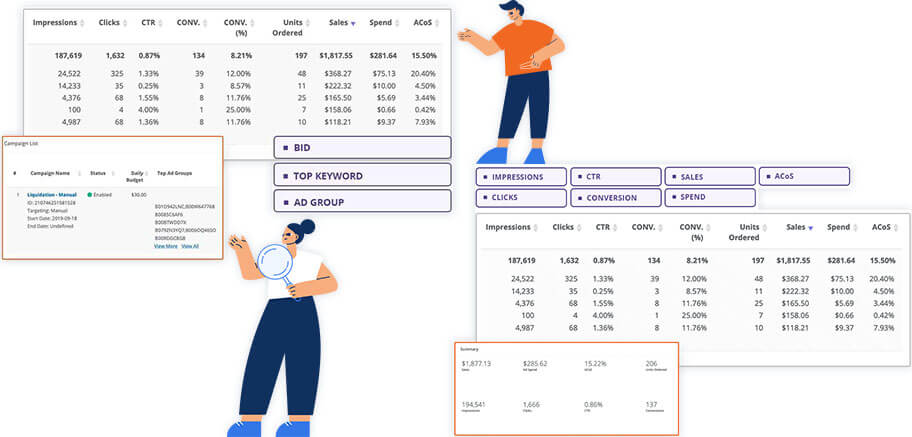
Otherwise, you can see this number in your Seller Central’s “Advertising” section, where you can find “Campaign Manager,” revealing your ad spending efficiency through Amazon advertising RoAS.
When we evaluate RoAS Amazon, the logic is different than that for TACoS and ACoS. Here, the higher the number, the better. It is important to note that a high RoAS does not necessarily mean high profits, as it only measures ad spend efficiency and not overall profitability. Therefore, it is crucial to consider other metrics, such as ROI and profit margins, when evaluating the success of your ad campaigns.
Higher RoAS means you gain higher profits per dollar spent on advertising.
So, what is a good RoAS on Amazon?
Usually, a 2:1 RoAS ratio is considered a good benchmark, meaning you earn $2 for every $1 spent on ads. RoAS closer to 3 or 4 is desirable, while a ratio below 1 means you are losing money on your ad campaigns.
How to Improve RoAS?
Aside from the general optimization of your ad campaigns, we recommend you treat RoAS Amazon as a comparative metric rather than an absolute one. This means comparing your RoAS to industry averages and your own past performance, as well as monitoring it over time.
To improve RoAS, you can try experimenting with different ad formats, targeting options, and bidding strategies to find what works best for your products and target audience. It is also important to regularly review and adjust your keywords and ad messaging to ensure they are relevant and effective.
In some cases, you may gain lower RoAS from certain advertising types, but they may still be valuable for driving brand awareness, Amazon seller awareness and long-term sales. Therefore, it is important to consider your overall business goals when evaluating RoAS.
How to Track Amazon Sales Metrics Effectively? SellerMobile Can Help!
Here’s how your Amazon data flows through the platforms before it reaches you in an insightful form.
- Step 1: Everything happening in your Amazon account is recorded and transferred to Amazon Seller Central.
- Step 2: Amazon Seller Central groups and categorizes raw data into corresponding Amazon seller metrics.
And if you want to go a step further and turn those Amazon seller metrics into insightful suggestions, add the third step.
- Step 3: You link SellerMobile – a specialized Amazon sales analytics software, to your Seller Central account and get real-time notifications and improvement suggestions even without logging in.
Why Is SellerMobile a Must for Amazon Tracking?
SellerMobile frees you from the headache of analyzing and interpreting Amazon data. It automatically identifies the areas you need to work on and provides helpful advice on how to do it.
For example, SellerMobile’s inventory analytics tool regularly updates you on your sell-through rate, meanwhile hinting at your lost revenue and inventory stock risks. This way, you always know when to act and how to start selling more.
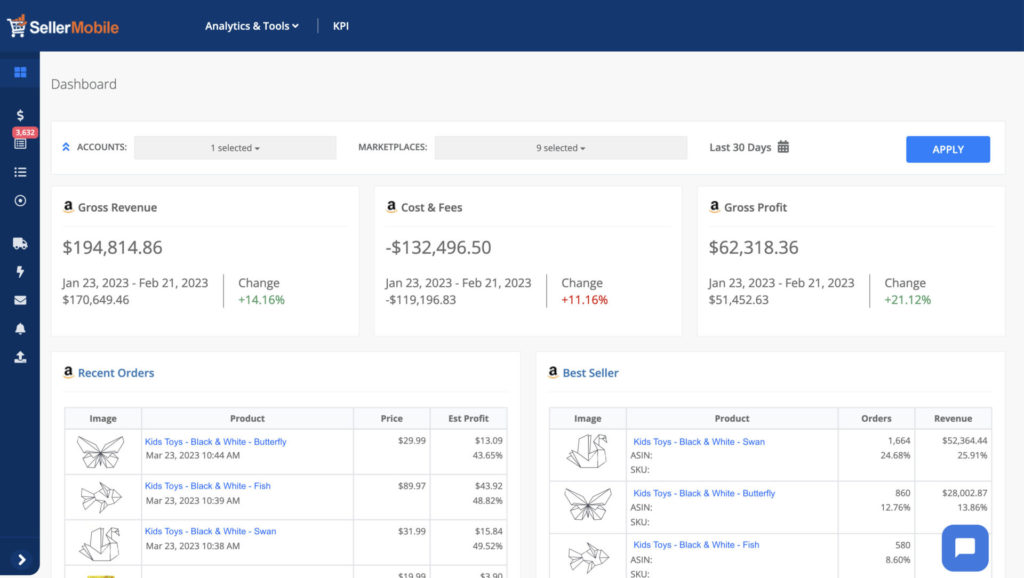
Want to ensure you’re always stocked to meet customer demand and increase fulfillment performance? No problem! SellerMobile will send you short notifications when you need to replenish your inventory and which items need to be restocked.
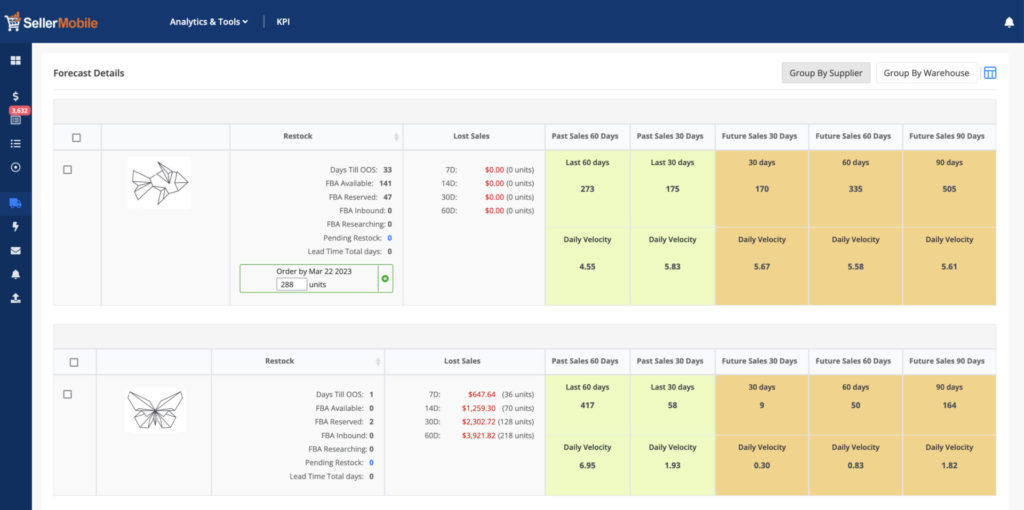
And yes! If, after all these efforts, any customer happens to be unhappy with your product or customer service, SellerMobile will instantly alert you to see the negative review, take appropriate action and fix the problem.
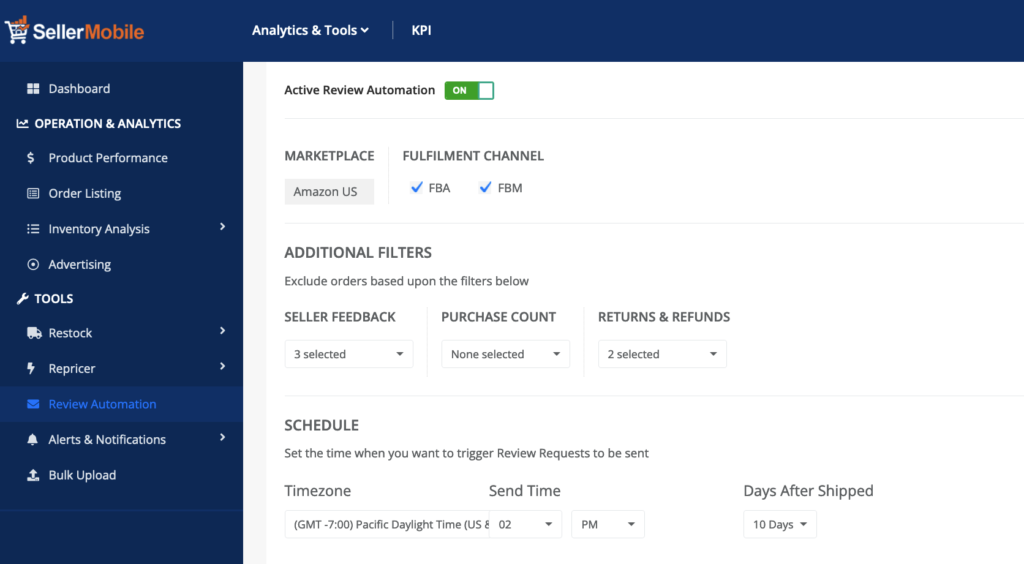
You can get peace of mind that even without manual tracking, you will always know what’s going on in your Amazon business and how to improve it.

Bottom Line
So, you know the key Amazon seller metrics you need to track and the industry-leading software to help you do it accurately.
All that’s left to you?
Do a puzzle and merge these two to get a comprehensive insight into your Amazon business performance and make informed decisions!






